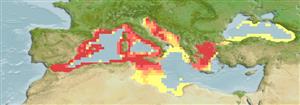Suberites domuncula (Olivi, 1792)
Sea-orange| Native range | All suitable habitat | Point map | Year 2050 |

|
| This map was computer-generated and has not yet been reviewed. |
| Suberites domuncula AquaMaps Data sources: GBIF OBIS |
Upload your photos
Google image |
No photo available for this species.No drawings available for Suberitidae.
Google image |
No photo available for this species.
Classification / Names Common names | Synonyms | CoL | ITIS | WoRMS
Demospongiae | Suberitida | Suberitidae
Environment: milieu / climate zone / depth range / distribution range Ecology
Sessile; depth range 0 - 1100 m (Ref. 119523). Polar
Distribution Countries | FAO areas | Ecosystems | Occurrences | Introductions
Arctic, Northeast Atlantic and the Mediterranean. Subtropical to polar.
Length at first maturity / Size / Weight / Age
Maturity: Lm ? range ? - ? cm Max length : 10.0 cm WD male/unsexed; (Ref. 358)
Short description Morphology
Sponge of more or less spherical form. Maximum diameter: 10 cm. Smooth surface; comprising only some small channels; often even one and single. Consistency charnue; not very elastic. Variable coloring; of orange to the marbled light blue.
Maximum diameter: 10 cm (Ref. 358).
Life cycle and mating behavior Maturity | Reproduction | Spawning | Eggs | Fecundity | Larvae
Members of the class Demospongiae are hermaphroditic. Life cycle: The zygote develops into parenchymella larva (free-swimming) before settling down on a substrate where it grows into a young sponge.
Main reference
References | Coordinator | Collaborators
Göthel, H. 1992. (Ref. 358)
IUCN Red List Status (Ref. 130435: Version 2024-1)
CITES status (Ref. 108899)
Not Evaluated
CMS (Ref. 116361)
Not Evaluated
Threat to humans
Human uses
| FishSource |
Tools
More information
Trophic Ecology
Food items
Diet
Food consumption
Ration
Predators
Diet
Food consumption
Ration
Predators
Ecology
Population dynamics
Life cycle
Distribution
Human Related
Aquaculture profile
Stamps, Coins Misc.
Stamps, Coins Misc.
Outreach
References
Internet sources
BHL | BOLD Systems | CISTI | DiscoverLife | FAO(Publication : search) | Fishipedia | GenBank (genome, nucleotide) | GloBI | Gomexsi | Google Books | Google Scholar | Google | PubMed | Tree of Life | Wikipedia (Go, Search) | Zoological Record
Estimates based on models
Preferred temperature
(Ref. 115969): 13.3 - 16.3, mean 14.3 (based on 24 cells).
Price category
(Ref. 80766):
Unknown.


